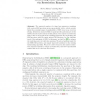Free Online Productivity Tools
i2Speak
i2Symbol
i2OCR
iTex2Img
iWeb2Print
iWeb2Shot
i2Type
iPdf2Split
iPdf2Merge
i2Bopomofo
i2Arabic
i2Style
i2Image
i2PDF
iLatex2Rtf
Sci2ools
DAM
2007
2007
Restricting SBH ambiguity via restriction enzymes
The expected number of n-base long sequences consistent with a given SBH spectrum grows exponentially with n, which severely limits the potential range of applicability of SBH even in an error-free setting. Restriction enzymes (RE) recognize specific patterns and cut the DNA molecule at all locations of that pattern. The output of a restriction assay is the set of lengths of the resulting fragments. By augmenting the SBH spectrum with the target string’s RE spectrum, we can eliminate much of the ambiguity of SBH. In this paper, we build on [20] to enhance the resolving power of restriction enzymes. We give a hardness result for the SBH+RE problem, and supply improved heuristics for the existing backtracking algorithm. We prove a lower bound on the number restriction enzymes required for unique reconstruction, and show experimental results that are not far from this bound.
| Added | 13 Dec 2010 |
| Updated | 13 Dec 2010 |
| Type | Journal |
| Year | 2007 |
| Where | DAM |
| Authors | Steven Skiena, Sagi Snir |
Comments (0)

